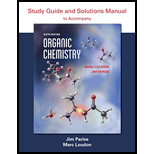
(a)
Interpretation:
The curved arrow mechanism for the given rearrangement reaction is to be shown.
Concept Introduction:
Benzylic protons are very acidic in nature as the conjugate base formed by the acid is resonance stabilized. Even a mild base can also abstract hydrogen ion. Intramolecular nucleophilic addition reaction takes place in those compounds in which nucleophile and electrophile both are present in the same compound.
(b)
Interpretation:
The curved arrow mechanism for the given rearrangement reaction is to be shown.
Concept Introduction:
Bromosuccinimide is a source of bromine radical. It can undergo various reactions. Nucleophilic addition reaction uses a nucleophile such as hydroxide ion which attacks at the electrophilic centre of the given compound to form nucleophilic addition product.
(c)
Interpretation:
The curved arrow mechanism for the given rearrangement reaction is to be shown.
Concept Introduction:
Acyl azide is heated in an inert solvent to form isocyanate with loss of nitrogen as by product. This reaction is known as Curtius rearrangement reaction. Isocyanate product of the rearrangement can be converted into amine by hydration in either an acid or base.
Want to see the full answer?
Check out a sample textbook solution
Chapter 23 Solutions
Organic Chemistry Study Guide and Solutions
- Name the following carbohydrates give both the systematic and common names. Don't forget to identify the Isomer.arrow_forwardWhat is the product of the reaction of XeF4 with H2O? Group of answer choices H2XeF2 H2XeF4 XeO3 H2XeOarrow_forwardWhile noble gas exerts the strongest London (dispersion) forces on neighboring atoms? Group of answer choices Xe Ar Kr Nearrow_forward
- Which of the following elements is corrosive to your skin due to that element breaking down C=C bonds? Group of answer choices fluorine iodine bromine chlorinearrow_forwardWhat the best source of sulfide to use on a small scale in the lab? Group of answer choices thiourea H2S NaHS Na2Sarrow_forwardWhich of the following statements about sulfur is FALSE? Group of answer choices H2S is the product of an oxygen-depleted ecosystem. In the acid mine drainage reaction, FeS2 is a product. One allotrope of sulfur has the formula S20. In the environment, bacterial oxidation can convert S2− to elemental S or SO42−.arrow_forward
- Of the following choices, which is the best reason that most materials DON'T spontaneously combust even though our atmosphere is about 21% oxygen? Group of answer choices The reduction of O2 in the gas phase (O2 + e− → O2−) is spontaneous. The reduction of O2 in acid solution (O2 + H+ + e− → HO2(aq)) is spontaneous. O2 is not a reactant in combustion. The O2 bond dissociation energy is 494 kJ/mol, leading to a high activation energy for combustion.arrow_forwardplease answer in the scope of the SCH4U course, I am having a hard time understanding, may you show all steps please and thank you! can you also put the final answers in the table so its understandablearrow_forwardPlan the synthesis of the following compound using the starting material provided and any other reagents needed as long as carbon based reagents have 3 carbons or less. Either the retrosynthesis or the forward synthesis (mechanisms are not required but will be graded if provided) will be accepted if all necessary reagents and intermediates are shown (solvents and temperature requirements are not needed unless specifically involved in the reaction, i.e. DMSO in the Swem oxidation or heat in the KMnO4 oxidation). There may be more than one correct answer, and chemically correct steps will be accepted. Extra points will be given if correct names are provided. The points earned here will be applied to your lowest exam score! H Harrow_forward
 Organic ChemistryChemistryISBN:9781305580350Author:William H. Brown, Brent L. Iverson, Eric Anslyn, Christopher S. FootePublisher:Cengage Learning
Organic ChemistryChemistryISBN:9781305580350Author:William H. Brown, Brent L. Iverson, Eric Anslyn, Christopher S. FootePublisher:Cengage Learning
